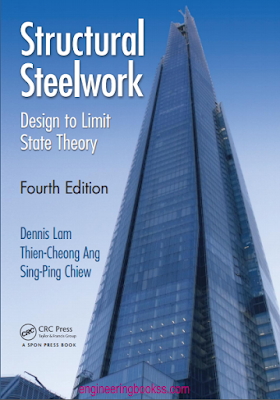Download Structural Steelwork Design to Limit State Theory Fourth Edition Edit By Dennis Lam and Thien-Cheong Ang
Contents Civil Engineering :
1- Introduction
2- Limit-state design
3- Materials
4- Beams
5- Plate girders
6- Tension members
7- Compression members
8- Trusses and bracing
9- Portal frames
10- Connections
11- Workshop steelwork design example
12- Steelwork detailing
Preface Structural Steelwork Design to Limit State Theory :
This is the fourth edition of the Structural Steelwork: Design to Limit State Theory, which proved to be very popular with both students and practising engineers. All the chapters have been updated and rearranged to comply with the Eurocode 3, Design of Steel Structures. In addition, it is also compliant with the other Eurocodes such as Eurocode 0, Basis of Structural Design, and Eurocode 1, Action of Structures. The book contains a detailed explanation of the principles underlying steel design and is intended for students reading for civil and/or structural engineering degrees in universities. It will also be useful for final year students involved in design projects and for practising engineers and architects who require an introduction to the Eurocodes. The topics are illustrated with fully worked examples, and problems are also provided for practice.
Dennis Lam is the chair professor of structural engineering at the University of Bradford, United Kingdom, and visiting professor at Hong Kong Polytechnic University. He is the president of the Association for International Cooperation and Research in Steel–Concrete Composite Structures and the chair of the Research Panel for the Institution of Structural Engineers. He is also a member of the British Standard Institution B525 and European Committee for Standardization CEN/T250/SC4 responsible for BS5950 and Eurocode 4.
These three types cover many of the uses of steel-frame buildings such as factories, warehouses, offices, flats and schools. A design for the lattice roof building (Figure 1.1a) is given, and the design of the elements for the braced multistorey building (Figure 1.1c) is also included. The design of portal frame is described separately in Chapter 9.
The building frame is made up of separate elements – the beams, columns, trusses and bracing – listed beside each section in Figure 1.1. These must be joined together, and the building attached to the foundations. The elements are discussed more fully in Section 1.2. Buildings are 3D and only the sectional frame has been shown in Figure 1.1. These frames must be propped and braced laterally so that they remain in position and carry the loads without buckling out of the plane of the section. Structural framing plans are shown in Figures 1.2 and 1.3 for the building types illustrated in Figure 1.1a and c.
Various methods for analysis and design have been developed over the years. In Figure 1.1, the single-storey structure in (a) and the multistorey building in (c) are designed by the simple design method, whilst the portal frame in (b) is designed by the continuous design method. All design is based on Eurocode 3 (EN1993). Design theories are discussed briefly in Section 1.4, and design methods are set out in detail in Chapter 2.


Post a Comment